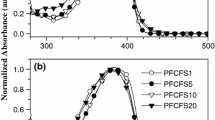Abstract
Copolymers containing alternating flexible aliphatic blocks and rigid poly (p-phenylenevinylene) (PPV) blocks were synthesized and characterized. It was found that the fluorescent intensity increases with increasing length of the flexible blocks. Bright blue-light emitting diodes were fabricated using PPV copolymers as electroluminescent layers. The devices show 190 cd/m2 light-emitting brightness at 460 nm and 15 V turn-on voltage. The effects of oxadiawle derivative PBD and tris(8-hydroxyquinoline) aluminum Alq3 electron-transporting layers on the luminance and stability of the devices are discussed.
Similar content being viewed by others
References
Burroughes, J. H., Bradley, D. D. C., Brown, A. R. et al., Light-emitting diodes based on conjugated polymer,Nature, 1990, 347:539.
Brown, A. R., Bradley, D. D. C., Burroughes, J. H. et al., Poly(p-phenylenevinylene) light-emitting diodes: enhanced electroluminescent efficiency through charge carrier confinement,Appl. Phys. Lett., 1992, 61:2793.
Greenham, N. C., Moratt, S. C., Bradley, D. D. C. et al., Efficient light-emitting diodes based on polymer with high electron affinities,Nature, 1993, 365:628.
Zhang, C., Von Seggern, H., Pakbaz, K. et al., Blue electroluminescent diodes utilizing blends of poly(p-phenylenevinylene) in poly(9-vinylcarbazole),Synth. Met., 1994, 62: 35.
Zhang, C., Von Seggern, H., Kraabel, B., Blue emission from polymer light-emitting diodes using non-conjugated polymer blends with air-stable electrodes,Synth. Met., 1995, 72:185.
Zyung, T., Hwang, D. H., Kang, I. N. et al., Novel blue electroluminescent polymers with well-defined conjugated length,Chem. Mater., 1995, 7:1499.
Yang, Z., Sokolik, I., Karasz, F. E., A soluble blue-light-emitting polymer,Macromolecules, 1993, 26:1188.
Jenekhe, S. A., Osaheni, J. A., Enhancement of luminescence in polymer nanocomposites,Chem. Mater., 1994, 6:1906.
Burrowa, P. E., Forrest, S. R., Electroluminescence from trap-limited current transport in vacuum-deposited organic lightemitting devices,Appl. Phys. Lett., 1994, 64:2285.
Author information
Authors and Affiliations
Additional information
Project supported by the National Natural Science Foundation of China, PCLCC, the State Comission of Science and Technology of China (863-715-002-0130) and the Chinese Acadeny of Sciences (KJ951-A1-501-01)
Rights and permissions
About this article
Cite this article
Ma, D., Zhao, X., Hong, Z. et al. Blue-light emitting diodes and flat display based on poly (p-phenylenevinylene) copolymers. Sc. China Ser. B-Chem. 41, 272–277 (1998). https://doi.org/10.1007/BF02879707
Received:
Issue Date:
DOI: https://doi.org/10.1007/BF02879707




